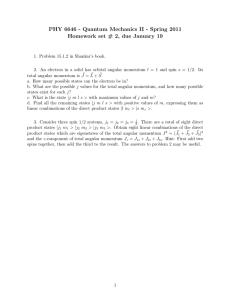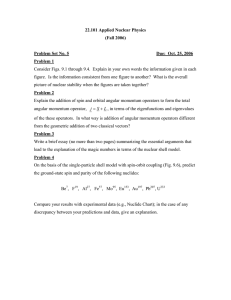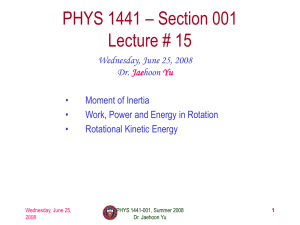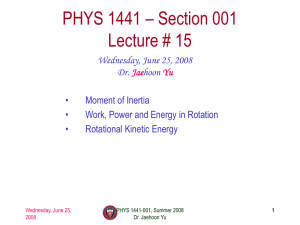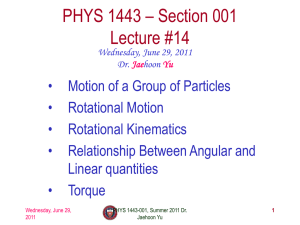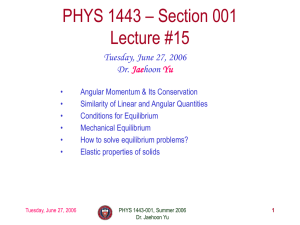Wednesday, July 21, 2004
advertisement
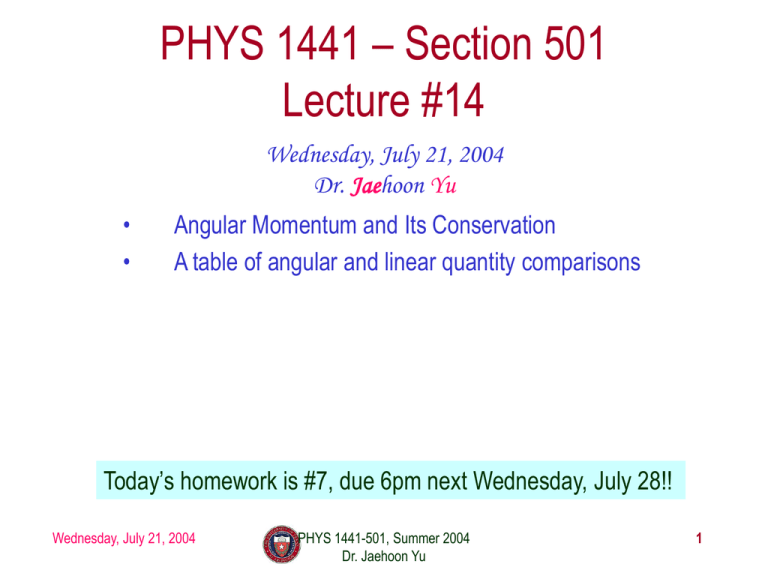
PHYS 1441 – Section 501 Lecture #14 Wednesday, July 21, 2004 Dr. Jaehoon Yu • • Angular Momentum and Its Conservation A table of angular and linear quantity comparisons Today’s homework is #7, due 6pm next Wednesday, July 28!! Wednesday, July 21, 2004 PHYS 1441-501, Summer 2004 Dr. Jaehoon Yu 1 Announcements • Term2 exam results – Average: 63.8 – Top score: 94 – How did you do in term 1? • 60.9 • 2nd quiz next Monday, Aug. 2 – Section 8.6 – whatever we cover till next Wednesday • Final term exam Wednesday, Aug. 11 – Covers: Section 8.6 – wherever we cover by Aug. 4 – Review on Aug. 11 • We will go through the exam problems together and will have individual discussions on how you could improve Wednesday, July 21, 2004 PHYS 1441-501, Summer 2004 Dr. Jaehoon Yu 2 Conservation of Angular Momentum Remember under what condition the linear momentum is conserved? Linear momentum is conserved when the net external force is 0. F 0 dp dt p const By the same token, the angular momentum of a system is constant in both magnitude and direction, if the resultant external torque acting on the system is 0. What does this mean? dL ext 0 dt L const Angular momentum of the system before and after a certain change is the same. ur ur L i L f constant Three important conservation laws for isolated system that does not get affected by external forces Wednesday, July 21, 2004 Ki U i K f U f ur ur pi p f ur ur Li L f PHYS 1441-501, Summer 2004 Dr. Jaehoon Yu Mechanical Energy Linear Momentum Angular Momentum 3 Example for Angular Momentum Conservation A star rotates with a period of 30days about an axis through its center. After the star undergoes a supernova explosion, the stellar core, which had a radius of 1.0x104km, collapses into a neutron start of radius 3.0km. Determine the period of rotation of the neutron star. What is your guess about the answer? Let’s make some assumptions: Using angular momentum conservation The period will be significantly shorter, because its radius got smaller. 1. There is no torque acting on it 2. The shape remains spherical 3. Its mass remains constant Li L f I i I f f The angular speed of the star with the period T is Thus Tf I i mri 2 2 f If mrf2 Ti 2 f r f2 2 r i Wednesday, July 21, 2004 2 T 2 3 . 0 6 Ti 2 . 7 10 days 0.23s 30 days 4 1 . 0 10 PHYS 1441-501, Summer 2004 Dr. Jaehoon Yu 4 Similarity Between Linear and Rotational Motions All physical quantities in linear and rotational motions show striking similarity. Quantities Mass Length of motion Speed Acceleration Force Work Power Momentum Kinetic Energy Wednesday, July 21, 2004 Linear Mass M Distance r t v a t L v I mr 2 Angle (Radian) t t P F v Torque I Work W P p mv L I Force F ma Work W Fd cos Kinetic Rotational Moment of Inertia K 1 mv 2 2 PHYS 1441-501, Summer 2004 Dr. Jaehoon Yu Rotational KR 1 I 2 2 5

